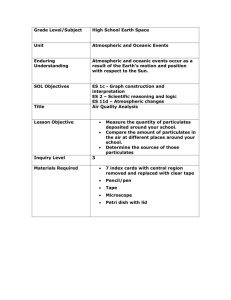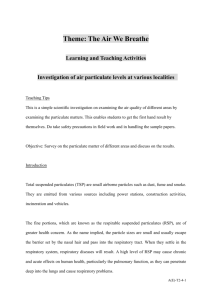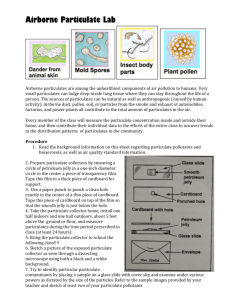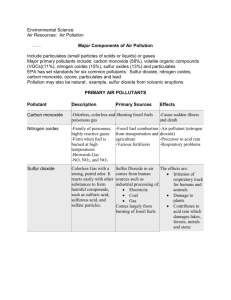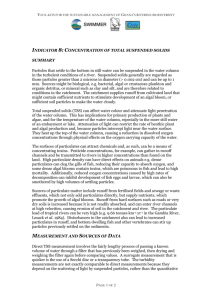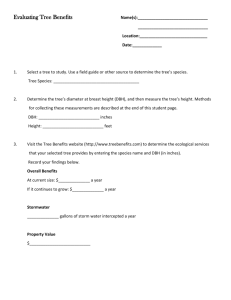Measuring Particulate Air Pollution
advertisement
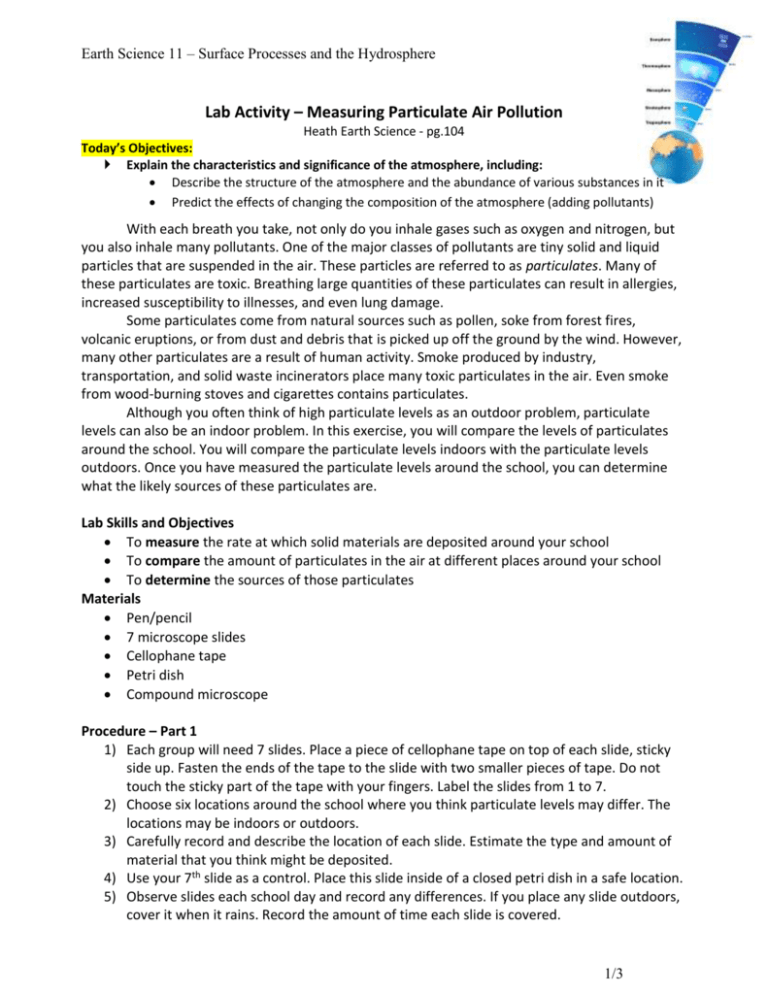
Earth Science 11 – Surface Processes and the Hydrosphere Lab Activity – Measuring Particulate Air Pollution Heath Earth Science - pg.104 Today’s Objectives: Explain the characteristics and significance of the atmosphere, including: Describe the structure of the atmosphere and the abundance of various substances in it Predict the effects of changing the composition of the atmosphere (adding pollutants) With each breath you take, not only do you inhale gases such as oxygen and nitrogen, but you also inhale many pollutants. One of the major classes of pollutants are tiny solid and liquid particles that are suspended in the air. These particles are referred to as particulates. Many of these particulates are toxic. Breathing large quantities of these particulates can result in allergies, increased susceptibility to illnesses, and even lung damage. Some particulates come from natural sources such as pollen, soke from forest fires, volcanic eruptions, or from dust and debris that is picked up off the ground by the wind. However, many other particulates are a result of human activity. Smoke produced by industry, transportation, and solid waste incinerators place many toxic particulates in the air. Even smoke from wood-burning stoves and cigarettes contains particulates. Although you often think of high particulate levels as an outdoor problem, particulate levels can also be an indoor problem. In this exercise, you will compare the levels of particulates around the school. You will compare the particulate levels indoors with the particulate levels outdoors. Once you have measured the particulate levels around the school, you can determine what the likely sources of these particulates are. Lab Skills and Objectives To measure the rate at which solid materials are deposited around your school To compare the amount of particulates in the air at different places around your school To determine the sources of those particulates Materials Pen/pencil 7 microscope slides Cellophane tape Petri dish Compound microscope Procedure – Part 1 1) Each group will need 7 slides. Place a piece of cellophane tape on top of each slide, sticky side up. Fasten the ends of the tape to the slide with two smaller pieces of tape. Do not touch the sticky part of the tape with your fingers. Label the slides from 1 to 7. 2) Choose six locations around the school where you think particulate levels may differ. The locations may be indoors or outdoors. 3) Carefully record and describe the location of each slide. Estimate the type and amount of material that you think might be deposited. 4) Use your 7th slide as a control. Place this slide inside of a closed petri dish in a safe location. 5) Observe slides each school day and record any differences. If you place any slide outdoors, cover it when it rains. Record the amount of time each slide is covered. 1/3 Earth Science 11 – Surface Processes and the Hydrosphere Procedure – Part 2 6) At the end of the experiment, retrieve the slides (probably 8-9 days later). Be careful not to touch the tape on the slides. Discard any slides that have large objects, such as insects or leaves, on them. 7) Use a microscope to observe the types of particulates that have accumulated on each slide. Briefly describe the size and shape of the particulates. 8) Set the microscope at 100X magnification. Without moving the slide, count all the particulates you see. Record your total count on Data Table A. 9) Now move the slide so that you are looking at a different field of view that doesn’t overlap the first, and count and record the number of particulates. Repeat this two more times and record your data in Data Table A. 10) Calculate the average particulate count on each slide, and record on Data Table A. 11) Subtract the average particulate count on the slide you used as a control from the average particulate count on each experimental slide. This will give the actual number of particulates deposited on the slides over the term of the experiment. Record on Data Table A. 12) Calculate the number of particulates deposited per square meter. (multiply avg. particulate count by 62 to give number of particles per sq. cm., then multiply by 10,000 to give number of particulates per sq. m). Record in Data Table A 13) Calculate the number of particulates deposited per square meter per day (divide number of particulates per sq. meter by number of days the slides were exposed). Record in Data Table A. 14) Answer the questions in Analysis and Conclusions. Data Table A Slide 1 Slide 2 Slide 3 Slide 4 Slide 5 Slide 6 Days Exposed Field 1 Field 2 Field 3 Field 4 Average Count Average Count – Average Count Control Particulates/cm 2 Particulates Deposited/day 2/3 Slide 7 (Control) Earth Science 11 – Surface Processes and the Hydrosphere Analysis and Conclusions /10 1) Compare the number of particulates deposited in each area. Where did you find the most particulates? Where did you find the least? How did the numbers compare to your predictions? __________________________________________________________________________ __________________________________________________________________________ __________________________________________________________________________ __________________________________________________________________________ __________________________________________________________________________ 2) Based on your description of the particulates, did the types of particulates differ from place to place? Were there significant differences in the particulate levels indoors and outdoors? Explain your answer. __________________________________________________________________________ __________________________________________________________________________ __________________________________________________________________________ __________________________________________________________________________ __________________________________________________________________________ 3) What do you think are sources for particulates? __________________________________________________________________________ __________________________________________________________________________ __________________________________________________________________________ 4) What do you think would lead to high particulate levels indoors? __________________________________________________________________________ __________________________________________________________________________ __________________________________________________________________________ 5) The severity of outdoor air pollution often depends on weather conditions. Explain how weather conditions might affect the particulate levels from day to day. __________________________________________________________________________ __________________________________________________________________________ __________________________________________________________________________ __________________________________________________________________________ __________________________________________________________________________ 3/3
